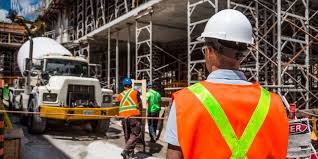Canada Construction Jobs for Africans
Canada’s construction sector remains one of the most important engines of jobs and economic growth and for many Africans looking to build a new life abroad, it’s one of the clearest routes to steady work, fair pay, and pathways to permanent residence.
This guide explains the real opportunities and the practical steps you’ll need in 2025: which trades are in demand, how immigration channels work for tradespeople, certification and licensing, expected wages, job search strategies, and tips to make your transition smoother.
Why construction is a strong option in 2025
Canada has continued to invest heavily in housing, infrastructure, and industrial projects (including energy transition, chemical and hydrogen plants), sustaining demand for tradespeople.
The federal government and provinces have programs and incentives aimed specifically at bringing internationally trained tradesworkers into the workforce and helping them credential and integrate.
For example, the federal government has recently funded programs to help internationally trained construction professionals join the trades workforce.
That said, the sector is cyclical and regional — some provinces (Alberta, Ontario, British Columbia, Saskatchewan, Manitoba, and the Atlantic provinces) often have the largest construction pipelines — so opportunities depend on where construction activity is highest.
Industry reports in 2025 show mixed signals: some months vacancy rates have eased from pandemic peaks, but skilled-trades shortages persist in specific occupations and regions.
Most in-demand construction trades for immigrants
The trades employers most commonly recruit from abroad include:
-
Carpenters and cabinetmakers (residential and commercial framing, finishing)
-
Welders and metal fabricators (infrastructure and industrial projects)
-
Plumbers, pipefitters, steamfitters (industrial and building systems)
-
Electricians (construction/installation and maintenance)
-
Ironworkers and steel erectors (bridges, high-rise construction)
-
Heavy equipment operators (earthmoving, roadwork)
-
Sheet metal workers and HVAC technicians
-
Construction labourers and helpers (entry-level to site-specialist roles)
Many of these trades are part of Canada’s Red Seal interprovincial standards — a nationally recognized credential that makes it easier to work across provinces. Holding a Red Seal endorsement significantly improves employability in Canada’s interprovincial labour market.
Immigration pathways that suit tradespeople
There are several routes you can use to work in Canada as a tradesperson. Which is best depends on your experience, whether you already have a Canadian job offer, and whether you want temporary or permanent status.
Express Entry Federal Skilled Trades / Category-based rounds
The Federal Skilled Trades Program (FSTP) within Express Entry is designed for skilled trades workers and remains a core route to permanent residence for qualified tradespeople.
It requires trade-specific experience and typically a job offer or certificate of qualification in Canada (depending on the trade). In addition, IRCC periodically runs category-based draws that specifically target trade occupations.
If you meet the detailed eligibility rules, Express Entry can be a fast path to PR. Government of Canada+1
Provincial Nominee Programs (PNPs)
Provinces facing localized shortages nominate foreign workers for permanent residence through PNPs. Some provinces operate skilled trades streams (e.g., Ontario’s Skilled Trades / Express Entry interest notifications; various PNPs for construction trades) and may prioritize applicants with trade experience or employer job offers in the region.
If you’re targeting a province, check that province’s PNP streams and eligible trades.
Temporary Work — Labour Market Impact Assessment
Employers can hire foreign workers temporarily using LMIA-backed work permits through the Temporary Foreign Worker Program (TFWP). This is common for construction firms needing immediate labour.
Temporary work can lead to permanent status later (through Canadian work experience and PNPs). Note: some programs (like the Atlantic Immigration Program) have employer-driven pathways that can combine job offers with settlement supports. Atlantic Immigration Program & Rural Programs
The Atlantic provinces run employer-driven programs that have been used to hire tradespeople for local construction and infrastructure projects. Smaller jurisdictions and rural streams within PNPs sometimes actively recruit experienced tradesworkers.
Apprenticeships & bridging programs
If your credentials don’t match Canadian standards, you can start as an apprentice or join bridging/upskilling programs designed for internationally trained tradespeople. Many provinces and colleges run such programs.
Certification, credential recognition, and the Red Seal
A practical reality: many construction jobs in Canada require provincial certification or proof of competence. Red Seal endorsement remains the benchmark for many trades; it’s an endorsement that indicates you meet the national standard for your trade.
If your trade is Red Seal-designated, you may be able to write an interprovincial exam (or have your training recognized) to receive the endorsement. Provinces control certification, but the Red Seal helps portability and employer confidence.
If you trained abroad:
-
Get your certificates and transcripts translated and certified.
-
Contact the provincial apprenticeship/credential body for your target province to learn about equivalency assessments.
-
Consider short bridging/upskilling courses in Canada that lead to challenge exams or journeyperson certification.
Expected pay what you can reasonably expect in 2025
Wages vary widely by trade, experience, and province. According to the Government of Canada Job Bank (market reports updated late 2024), a construction labourer/helper can earn roughly CAD $18–$38/hour across Canada (median around $25/hour), with some skilled trades and regions (Alberta, Ontario, BC) paying higher rates for experienced journeypersons.
Skilled trades like electricians, plumbers, welders, and heavy equipment operators typically earn higher median wages than general labourers. Use Job Bank data to check wage ranges by occupation and city before you negotiate.
Keep in mind: unionized sites (common in some provinces and sectors like large infrastructure, industrial maintenance, and oil & gas) often pay premium rates and provide benefits; non-union residential sites may pay less but sometimes offer faster entry-level hiring.
Regional snapshots — where to look
-
Alberta: Strong demand for industrial construction, energy projects, and maintenance season work. Wages can be above national averages in some trades, especially in oil and petrochemical regions.
-
Ontario: Large residential, commercial and infrastructure pipelines; PNP streams target trades. Big cities (Toronto, GTA) and surrounding regions offer many opportunities but higher living costs.
-
British Columbia: Ongoing residential and transit projects; high demand for carpenters, electricians, and millwrights.
-
Saskatchewan & Manitoba: Good openings for heavy equipment operators, welders, and general trades, particularly where resource and agricultural infrastructure projects exist.
-
Atlantic provinces (NS, NB, NL, PEI): Employer-driven programs and community demand for trades in housing and marine/industrial projects.
Always check provincial labour-market information and PNP lists for updated eligible occupations.
How to get hired step-by-step practical plan
-
Assess & document your experience
-
Create a clear CV focused on trade experience: start/end dates, employer details, duties, tools/machinery used, certifications, and photos of work if possible. Employers care about demonstrable hands-on experience.
-
-
Translate & certify documents
-
Translate training certificates, apprenticeship records, and letters of reference into English (or French for Quebec) and have them certified where possible.
-
-
Reach for Red Seal / provincial recognition
-
Contact the provincial apprenticeship authority for recognition and exam routes. If your trade is Red Seal eligible, pursue the Red Seal pathway (exam or bridging).
-
-
Search jobs & apply strategically
-
Use Job Bank, Indeed.ca, LinkedIn, and trade-specific boards. For Canada-specific hiring, include “open to immigration” or “willing to sponsor” in communications when appropriate.
-
Apply directly to contractors, union halls, and recruitment agencies. Some employers use LMIAs to hire internationals.
-
-
Pursue immigration streams in parallel
-
If eligible, create an Express Entry profile (FSTP or FSWP) and monitor category-based draws; also apply to targeted PNP streams. If you have a firm job offer, that boosts eligibility.
-
-
Be ready for interviews & references
-
Prepare to discuss site safety, tools you’ve used, hours/availability, and show portfolio photos. Canadian employers will check references — make sure referees can be reached.
-
-
Plan financially for relocation
-
Factor in airfare, initial housing, licensing fees, and living costs for the first 4–8 weeks. If you come on a temporary work permit, ensure you have the funds to support yourself until pay starts.
-
Common obstacles and how to overcome them
-
Credential mismatch: Many foreign-trained tradespeople face recognition hurdles. Solution: pursue bridging programs, write Red Seal exams where eligible, or start as an apprentice to upgrade credentials.
-
Language & safety standards: English or French proficiency and knowledge of Canadian workplace safety (e.g., WHMIS, site safety orientation) are required. Take language classes and obtain safety tickets (e.g., basic fall protection, WHMIS, Working at Heights) before arrival.
-
Geographic mismatch: You might have skills in demand in a different province. Be flexible about where you’ll work initially — many employers will help with temporary housing for high-demand workers.
-
Cultural differences in resumes/interviews: Format your CV to Canadian expectations (concise, results-focused) and practice interview questions common to trades (situational safety questions, examples of teamwork).
Where to find trustworthy information & services
-
IRCC (Immigration, Refugees and Citizenship Canada) — for Express Entry and federal programs.
-
Job Bank (Government of Canada) — for wages, job outlook and regional labour information.
-
Provincial apprenticeship and certification authorities — for Red Seal and certification processes in your target province.
-
Local unions and employer associations — for hiring halls, unionized-site openings, and apprenticeship placement.
-
Verified recruitment agencies — when using agencies, verify registration and reviews; avoid services that demand large upfront fees for job placement.
Practical checklist before you move
-
Passport valid + scanned copies of documents
-
Certified translations of trade certificates and references
-
Updated trade CV + portfolio photos of your work
-
Copies of safety training (or plans to get them on arrival)
-
Proof of funds / initial living budget (unless employer provides relocation assistance)
-
Express Entry profile or PNP application in progress (if eligible)
-
Contact details for referees and former employers (phone/email)
-
Research housing and cost of living for your destination city
Quick FAQs
Q: Can I get permanent residence as a construction worker?
A: Yes. Many tradespeople obtain PR through Express Entry (Federal Skilled Trades), PNPs, or employer-driven provincial streams — especially if you have the required experience, job offer, or certificate of qualification.
Q: How long until I can work in my trade in Canada?
A: Timelines vary. If an employer sponsors you via LMIA, you may start work within months. Getting full journeyperson status or Red Seal recognition can take longer (months to a year depending on exams, bridging, or apprenticeship requirements).
Q: Are employers in Canada recruiting from Africa?
A: Yes — Canadian employers often recruit internationally when local labour markets can’t meet demand. Recruitment is common for skilled trades, particularly where employers will support LMIA or contract hiring. Government-funded initiatives also support internationally trained tradespeople to integrate.
Final advice concrete next steps for an African tradesperson
-
Inventory your skills and documents now. Make a trade CV and collect references.
-
Research your target province (costs, PNP streams, demand). Ontario and Alberta are common starting points for many trades, but Atlantic provinces and the Prairies also have openings depending on the trade.
-
Make an Express Entry profile if you meet minimums for the FSTP/Federal Skilled Worker. Monitor category-based draws that prioritize trades.
-
Start online job hunting and contact employers — apply to multiple postings, and be ready to show evidence of your hands-on skills. Use Job Bank, Indeed, LinkedIn, and trade-specific boards.
-
Plan finances and time — even with a job offer, initial relocation costs and licensing processes take planning.










